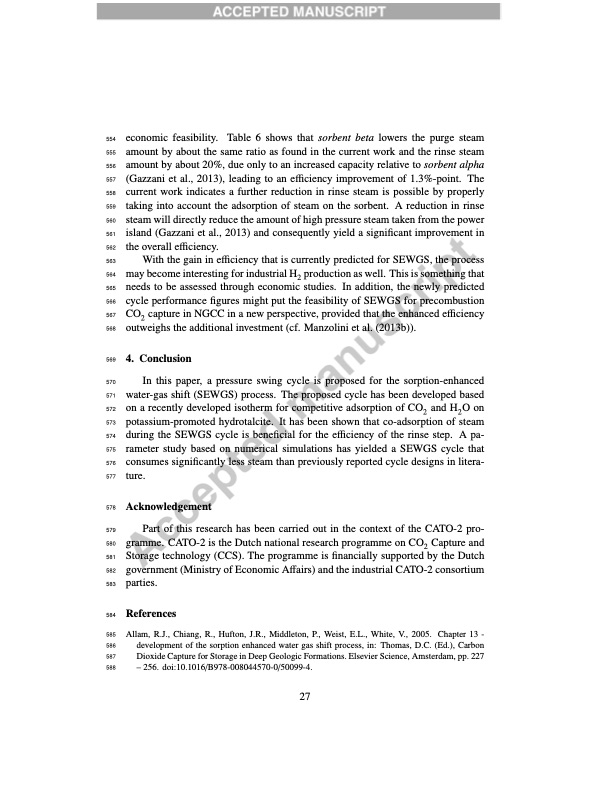
PDF Publication Title:
Text from PDF Page: 029
554 economic feasibility. Table 6 shows that sorbent beta lowers the purge steam 555 amount by about the same ratio as found in the current work and the rinse steam 556 amount by about 20%, due only to an increased capacity relative to sorbent alpha 557 (Gazzani et al., 2013), leading to an efficiency improvement of 1.3%-point. The 558 current work indicates a further reduction in rinse steam is possible by properly 559 taking into account the adsorption of steam on the sorbent. A reduction in rinse 560 steam will directly reduce the amount of high pressure steam taken from the power 561 island (Gazzani et al., 2013) and consequently yield a significant improvement in 562 the overall efficiency. 563 With the gain in efficiency that is currently predicted for SEWGS, the process 564 may become interesting for industrial H2 production as well. This is something that 565 needs to be assessed through economic studies. In addition, the newly predicted 566 cycle performance figures might put the feasibility of SEWGS for precombustion 567 CO2 capture in NGCC in a new perspective, provided that the enhanced efficiency 568 outweighs the additional investment (cf. Manzolini et al. (2013b)). 569 4. Conclusion 570 In this paper, a pressure swing cycle is proposed for the sorption-enhanced 571 water-gas shift (SEWGS) process. The proposed cycle has been developed based 572 on a recently developed isotherm for competitive adsorption of CO2 and H2O on 573 potassium-promoted hydrotalcite. It has been shown that co-adsorption of steam 574 during the SEWGS cycle is beneficial for the efficiency of the rinse step. A pa- 575 rameter study based on numerical simulations has yielded a SEWGS cycle that 576 consumes significantly less steam than previously reported cycle designs in litera- 577 ture. 578 Acknowledgement 579 Part of this research has been carried out in the context of the CATO-2 pro- 580 gramme. CATO-2 is the Dutch national research programme on CO2 Capture and 581 Storage technology (CCS). The programme is financially supported by the Dutch 582 government (Ministry of Economic Affairs) and the industrial CATO-2 consortium 583 parties. 584 References 585 Allam, R.J., Chiang, R., Hufton, J.R., Middleton, P., Weist, E.L., White, V., 2005. Chapter 13 - 586 development of the sorption enhanced water gas shift process, in: Thomas, D.C. (Ed.), Carbon 587 Dioxide Capture for Storage in Deep Geologic Formations. Elsevier Science, Amsterdam, pp. 227 588 – 256. doi:10.1016/B978-008044570-0/50099-4. 27PDF Image | High-temperature pressure swing adsorption cycle design for sorption

PDF Search Title:
High-temperature pressure swing adsorption cycle design for sorptionOriginal File Name Searched:
high-temperature-pressure-swing-adsorption.pdfDIY PDF Search: Google It | Yahoo | Bing
CO2 Organic Rankine Cycle Experimenter Platform The supercritical CO2 phase change system is both a heat pump and organic rankine cycle which can be used for those purposes and as a supercritical extractor for advanced subcritical and supercritical extraction technology. Uses include producing nanoparticles, precious metal CO2 extraction, lithium battery recycling, and other applications... More Info
Heat Pumps CO2 ORC Heat Pump System Platform More Info
| CONTACT TEL: 608-238-6001 Email: greg@infinityturbine.com | RSS | AMP |